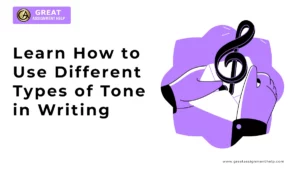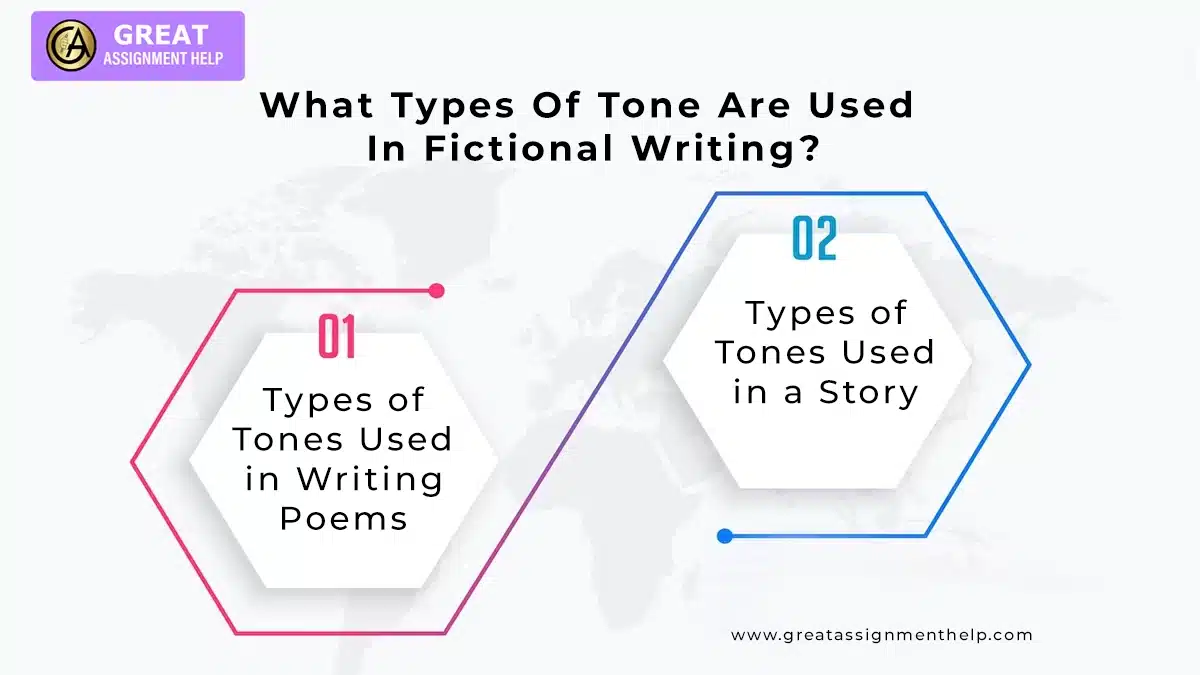Understanding types of tone in writing is crucial. When writing, you can use formal, informal, persuasive, or narrative tones. Each tone conveys a different attitude and engages your audience uniquely. However, by choosing the right tone, you can effectively convey your message and connect with your readers.
When communicating words through your mouth, you can take the help of gestures, pitch of voice, and body movements to express what you want to say. As a result, people can articulate the words in the way you want them to. However, this is not the case when you write about a subject or employ text to express your thoughts about a subject. You will not be present in front of the reader when they read your crafted texts. Therefore, you cannot connect with your audience and make your reader understand the content in the way you want to say it. However, this issue can be resolved if you know the types of tone in writing. In this blog, we have shared 18 tones. Whether you are a student or a professional, learning it will help you voice your thoughts appropriately.
What is a Tone in Writing?
Words evoke specific emotions and moods in the mind of the reader. The tone of writing refers to the mood that you try to induce in the reader’s mind through the use of specifically chosen words. Written content can have a soothing, exciting, uplifting tone or make you sorrowful or tense. It is also observed that a writer’s mood while crafting the content influences the overall mood of the piece. Sometimes you can share your feelings on the topic or situation to set the tone of the writing. Several other factors, like the verbs, adjectives, or images you use to tell a story, play a crucial role in setting the tone of your written piece.
Apart from emotions, tone in writing also depicts the formality or complexity of the words used in the content. A formal article will deal with a serious theme, while humorous content will employ less formal vocabulary and diction. The tone in the literature indicates the way authors showcase their thoughts through their work.
Tone may continue to remain consistent throughout a work or ebb and flow to symbolize progress in the story or mood. An author may also employ various types of tone in writing different sections of a piece.
What are the Different Types of Tone in Writing?

Here, let us have a look at the 18 different types of tones used in writing various academic or non-academic content:
1. Formal
A formal tone is commonly used in professional and academic settings. Here, the tonal quality must be simple, respectful, and direct. Formal writing often uses complete words without using any contractions or other shorter forms of words. Additionally, the formal tone of writing does not include slang jargon. It is grammatically and syntactically flawless and typically includes facts over opinions.
Here is a typical example of content developed in a formal tone.
According to the presented data, the yellow tree frog is mostly found between April and June in mesic broadleaf forests, riparian forests, grasslands, and marshes.
2. Informal
The informal tone of writing is the opposite of formal in tone and echoes a more conversational form. A tone sounds informal when you write in the same way you talk to a friend. Informal writing may incorporate colloquial or slang expressions and shorter words such as contractions. In an informal tone, you may state more emotion and personal thoughts in the written piece.
Here is an example of an informal tone in writing:
“Hey, how’s it going?” I’m calling to ask if you would like to come with me and my friends to watch a movie.
3. Tense
A suspenseful tone makes the reader guess what may take place next. When you write a mystery or thriller, you may use a cliffhanging tone to suggest feelings of dread and concern. In most stories, a tense tone connects to a resolution and brings a shift in the tone. Worried is another term used to depict a tense tone in writing content. It can make the reader feel anxious or apprehensive about what is about to take place.
Here are two examples of tense tones in writing.
“She quickly searched the room for the killer, who she was aware was in the darkness. She rushed blindly through the expanse, hoping to find and stop him before it was too late, and he went on to his next victim.”
4. Pessimistic
A pessimistic tone showcases a poor viewpoint on a situation or the idea that it will not progress. Pessimism is not realism. However, you may use this tone when you feel down or are trying to showcase an opposing point of view.
Here is an example of a type of pessimistic tone in writing:
“I was diagnosed with cancer, and my dog died.” “I just don’t think anything will improve very soon.”
5. Optimistic
Optimism is the contrast to a pessimistic tone. If you use an optimistic tone of writing, you see positivity in everything. Even in difficult times, an optimistic tone states the thought that things will improve.
For example, “Despite the civil disturbance in my city, I believe I can make things better and witness a meaningful change in my lifetime,”
6. Surprised
It’s not uncommon to see a post uploaded on social media become viral with a single attractive phrase or sentence. These posts usually go together with a funny picture or meme that makes readers laugh, smile, or even feel something more profound.
Surprise can also be created through an unexpected twist in your text.
The following are some examples
He was astonished after seeing a dead animal on the road.
It took her breath away.
Also read: Learn the Importance of Referencing in Academic Writing
7. Friendly
A friendly tone and kind conduct gain trust quite easily. Depending on the theme you are writing about, this tone might also incorporate a combination of professional and informal tones. In general, it has a happy and generous tone. Exclamation points can convey passion and friendliness.
Here are some examples of a friendly tone.
“Esther smiled broadly at me and nodded excitedly while remaining hidden behind the curtain.”
“What an amazing little dog!”
“Happy birthday, friend!”
8. Sad
The experience of sadness is a normal and unavoidable feature of being human. When a sad tone is employed in writing, the reader will feel compassion for the characters or the author, which will keep them interested in the narrative.
Here is an example of a type of pessimistic tone in writing:
The happiness of recollection had been taken from me because there was no longer anyone to remember with.
9. Worried tone
Your reader may get more afraid and concerned about the condition if you write in an anxious tone. It gives one the feeling of being in danger because of something unknown.
Find here some examples of a worried tone.
His nervousness level was high.
He approached the package with anxiety, not knowing what to expect.
10. Encouraging tone
The main objective of a writer is to give confidence to the reader through a cheerful tone in their writing. The reader will be able to overcome their qualms and become more self-reliant from reading the content.
Listed below are some examples of encouraging tone in writing.
You have got this, so permit yourself to take a deep breath.
My father always instructed me to jump with both feet together.
Let’s motivate and inspire one another to achieve our goals.
11. Curious
A sense of curiosity highlights that the writer or a character is paying attention to learning more about the topic, or that the reader will persist in learning new and relevant information. Writing with a sense of surprise is expected when the author discovers a topic for the first time or explains a child’s enthusiasm for learning. Keeping the reader engrossed is essential to keeping them reading.
Here is an example of the curious tone of writing:
On the way to school, he searched for answers, such as “Why are the birds soaring in a V-shaped pattern?” and “Will you be here to wake me up from my nap?”
12. Uplifting
Writing in an encouraging tone encourages hope and confidence in the reader, giving them the strength to encounter obstacles and go forward in their lives. Many authors and speakers in the self-help genre take a hopeful approach.
Here is an illustration of the uplifting tone of writing:
Johnson’s mother told him again to maintain a positive attitude and a smile on his first day back at school in his new wheelchair. He rolled himself into class, and his comrade classmates were more than happy to push his wheelchair and sit with him while talking about kind things and being supportive.
Read more: Learn How to Score the Best Grades in Any Academic Writing
13. Aggressive
To state annoyance or rage, one can use an aggressive tone. Using an aggressive tone implies employing hostile or nasty language to make points.
An example of such a sentence is as follows:
“The answer is no, and I don’t want to listen to another word about it for as long as we both live.” It indicates a complete refusal to consider further discussion of the topic.
14. Assertive
Many people mistakenly believe that an assertive tone is the same as an aggressive one, yet there is a noteworthy difference between the two. An aggressive tone comes out as furious or harsh, while an assertive one states authority and confidence. When writing confidently, authors typically unmistakably offer their points of view, which leaves little space for debate.
Example: She talked with unwavering conviction, and her audience felt bound to join the committee and resulting in a change in their neighborhood.
15. Informative
An instructive tone points toward educating the reader. A tone of voice is typically informative in academic materials.
Here is a typical example of an informative tone: The human brain, which includes millions of cells, synchronizes the body’s many activities.
16. Entertaining
The objective of adopting a humorous tone is to formulate the content in a more enjoyable form for the reader. It could be very funny and make the reader laugh, or it could just be amusing.
“Knock, knock, who’s there?” is an example of a doorbell ringing. Nobel. As in, “Nobel who?” There was no doorbell, so I knocked.
17. Sarcastic
Sarcasm is another type of tone of writing that is used to show disparagement or ridicule someone or something. Showing ironies like sarcasm through written words often becomes difficult. Therefore, it is most often illustrated through expressions of the character.
For example, Rachel rolled her eyes, said, “Okay, whatever you say goes,” and walked away purposefully from the bully.
18. Cooperative
Cooperative writing is used in most workplaces. It helps to place importance on the fact that everyone must work together and contribute to reach the same organizational goal. One of the most common aspects of texts written in a cooperative tone is positive expressions. It involves a willingness to work together.
For example, imagine you are about to propose a plan to begin a new project. You say words like, “After I present my proposal, I would like to listen to your remarks and will open the discussion with everyone on the team.”
What are the Types of Tone Used in Fictional Writing?

The following are the types of tones used in fictional works.
Types of Tones Used in Writing Poems
The tone of voice used in a poem can be in any of the following forms. It can have one type of tone of voice throughout the entire content or use a mixture of a few. Here are a few popular types of tones used while writing poems.
- lighthearted
- hilarious
- abashed
- abrasive
- abusive
- accepting
- acerbic
- acquiescent
- admiring
- adoring
- affectionate
- aghast
- allusive
- amused
- regretful
Also Read: How to Write an Elegy Poem
Types of Tones Used in a Story
The popular types of tone of voice used while writing a story are:
- worried
- foolish
- smart
- depressing
- scared
- anxious
- excited
Learn How to Compose Content with the Right Tone
To develop excellent content, you must select the right tone. There are various types of tones in writing. Therefore, whatever the type of tone you use in writing, make sure that you pass on your message to the audience in an accurate way. For academic papers, using a formal tone is best. However, for all other purposes, go for a conversational one.
Once you settle down, adhere to the following 5 tricks to develop excellent content.
- Use conversational voice. It will help the readers to get your point across seamlessly.
- Utilize words like we, our, etc., to connect with your readers and create more engaging content.
- Use shorter sentences.
- Remove redundant words
- Employ simple words
Conclusion
The different tones of writing listed in this blog will help you grab the attention of your readers effectively. In case you are unsure what tone to use and how to use the tone in your academic writing, call us quickly. The finest writers in our team who offer assignment help services will guide you in enhancing the quality of your work as per the standards.



